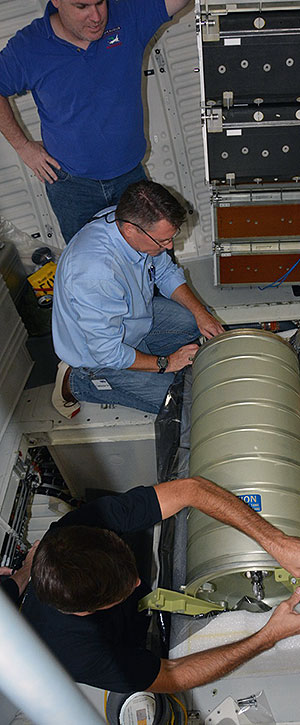 advertisements advertisements
|

|
Photos: NASA re-enters retired shuttles to remove tanks for station
August 26, 2015 — New behind-the-scenes photos reveal how the water storage tanks that were installed deep inside NASA's retired space shuttles Atlantis and Endeavour were recently removed by the space agency for future use onboard the International Space Station.
The photographs, which were shared with collectSPACE by NASA workers at the Kennedy Space Center in Florida and by the manager for Endeavour's display at the California Science Center in Los Angeles, show how the three-foot-long (0.9 meter) tanks were accessed under the floor of the orbiters' crew cabins and were then extracted through different hatches on each vehicle.
As collectSPACE was the first to report, the retired shuttles' potable water tanks were called back into service by NASA to support a new storage system for the space station. Currently, the astronauts' recycled drinking supply is stored aloft in soft, duffle-like bags that are time-consuming to fill.
The shuttles' tanks will allow for a larger integrated water reserve, freeing the crew to devote more time to science research aboard the orbiting laboratory.
"NASA assessed various options for the water storage system beginning in mid-2013," said Chad Rowe with NASA's space station vehicle office at the Johnson Space Center in Houston. "After evaluating the system concepts earlier this year, NASA decided to move forward and retrieve the tanks as a means to minimize project costs."
Unbeknownst to the public at the time, workers in May removed the water tanks from the space shuttle Atlantis, which is on exhibit at the Kennedy Space Center Visitor Complex.
Endeavour's four potable water tanks and one waste water tank were extracted last week at the California Science Center, where the orbiter has been on display inside the Samuel Oschin Endeavour Display Pavilion since 2012.
"The Endeavour waste water tank was shipped to the Kennedy Space Center for removal of some sensor and wiring components that will serve as spares for the storage system," Rowe explained. "The waste water tank will be returned to the California Science Center for reinstallation into Endeavour."
The tanks from Atlantis and Endeavour will be checked for cleanliness and leaks before being integrated to become the station's water storage system. They are not anticipated to need modifications.
NASA expects to launch the tanks within three to five years for likely installation in the U.S. "Destiny" laboratory, said Rowe.
"The current goal is to maximize the ability to fly key storage system components on multiple vehicles, including U.S commercial cargo vehicles," he said.
Other than Endeavour's waste water tank, any of the water tanks that do not fly to station will be retained by NASA for potential use as spares or for the potential future expansion of the water storage system. |
|

Photos credit: NASA Kennedy Space Center and the California Science Center/Dennis Jenkins. Photos cannot be reproduced without permission. |

Workers entered the space shuttle Endeavour, which is exhibited inside the California Science Center's Samuel Oschin Display Pavilion, through the same hatch that was used by the astronauts to enter and exit the space shuttle before launch and after landing. The hatch is normally kept closed as the center's visitors are not allowed to tour inside the vehicle. (California Science Center/Dennis Jenkins) |

Under the seats where mission specialists sat for launch and landing is a locker that held the lithium hydroxide (LiOH) canisters used to clean the orbiter's air of carbon dioxide. Lifting out that container offered a pathway to the tanks. (California Science Center/Dennis Jenkins) |

Each of the potable water tanks measures 3 feet long by 1.3 feet wide (0.9 by 0.4 m) and weighs 40 pounds empty (18 kg). Together with a single waste water tank of similar dimensions, they were installed underneath the crew cabin. (California Science Center/Dennis Jenkins) |

Seen here, workers remove Endeavour's waste water tank, as indicated by the brown stripes. After the removal of some sensor and wiring components, the waste water tank will be returned to the California Science Center and Endeavour. (California Science Center/Dennis Jenkins) |

NASA's current goal is to launch these water tanks to the space station full, pending identification of the launch vehicle and configuration. (California Science Center/Dennis Jenkins) |

Seen here, workers remove one of Endeavour's four potable water tanks. (California Science Center/Dennis Jenkins) |

View of Endeavour's lower level after removal of all four of its potable water and one waste water tanks. (California Science Center/Dennis Jenkins) |

Endeavour's water tanks were carefully crated for shipment to NASA's Kennedy Space Center in Florida, where they will join the similar tanks removed from space shuttle Atlantis to await their launch to the space station. (California Science Center/Dennis Jenkins) |

Removing Atlantis' water tanks presented a special challenge because of the angle at which the orbiter is displayed. Instead of entering through the crew hatch as they later did with Endeavour, workers had to be lowered on platforms into the payload bay to enter through the mockup of the shuttle's external airlock and docking adapter. (collectSPACE) |

Because Atlantis was mounted at an angle, NASA previously installed on the mid-deck a platform (yellow railing above) at the same angle to access the flight deck, if needed. The platform had to be repositioned to access the water tanks. (NASA/Kennedy Space Center / collectSPACE) |
|

© collectSPACE. All rights reserved.
|
|

|

|
